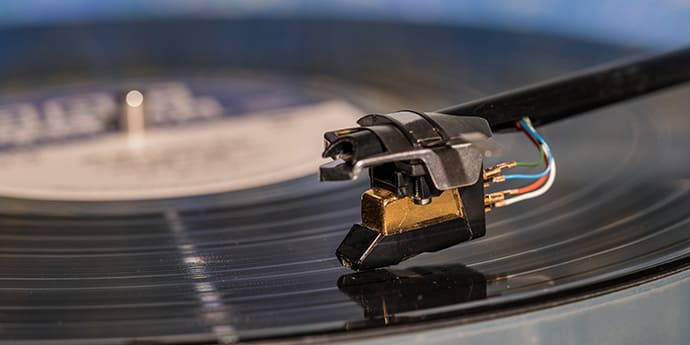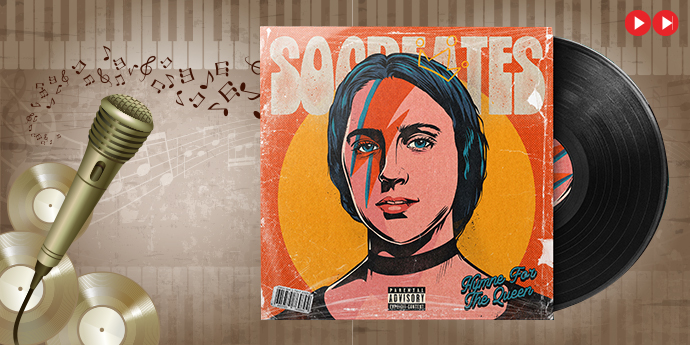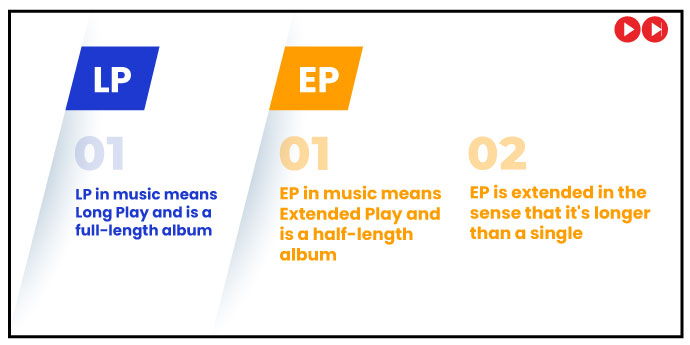What does EP stand for?
EPs need to be understood for those to be fully understood. As an acronym, it stands for extended player/playing.

What is EP Music?
An extended play record usually referred to as an EP, is a musical recording that contains more tracks than a single but fewer than an album or LP record. The contemporary EPs generally contain four or five tracks and are considered “less expensive and time-consuming for an artist to produce than an album. An EP originally refers to specific records other than 78 rpm standard play (SP) and LP. But it is now applied to mid-length CDs and downloads too. EPs are usually paired with vinyl records, mixtapes, singles, and albums which can typically be downloaded at no cost from Music streaming apps. One can search for specific artists or brands to find a few songs within an album.
EP albums are an excellent way for new artists to establish their fan base. The shorter EPs and more extended singles make them more suitable since they are generally shorter than albums and longer than singles.
What is an Extended Play or EP in the music industry and when did it start?

History of Extended Play/ EPs-
Learn all about what does ep means in the music industry and how Music is different by checking out its fascinating history.
In the days before vinyl record players, there was only live Music to be heard. Although they were not uninteresting, there were no better ways to listen to your favorite musicians at the time. EPs were released in various sizes in different eras. The earliest multi-track records, issued around 1919 by Grey Gull Records. It was vertically cut 78 rpm discs known as “2-in-1” records. It had finer than usual grooves, like Edison Disc Records. Then later by 1949, when the 45-rpm single and 331⁄3 rpm LP were competing formats, seven-inch 45 rpm singles had a maximum playing time of only about four minutes per side.
Partly as an attempt to compete with the LP introduced in 1948 by rival Columbia, RCA Victor introduced “Extended Play” 45s during 1952. Their narrower grooves, achieved by lowering the cutting levels and sound compression optionally, enabled them to hold up to 7.5 minutes per side—but still be played by a standard 45 rpm phonograph.
The early era record companies released the entire content of LPs as 45 rpm EPs. These were usually 10-inch LPs (released until the mid-1950s) split onto two seven-inch EPs or 12-inch LPs split onto three seven-inch EPs, either sold separately or together in gatefold covers. This kind of practice became much less common with the advent of triple-speed-available phonographs.
Confused? Let us simply do it for you –
One hundred seventy-seven years ago, Thomas Edison invented both the sonograph and the record player. The first Record we’ll discuss is “Mary Had a Little Lamb” since it was created as a single format and was the first Record created.
The format remained in use until the 1920s since it was the only one available at the time.
There was no limit to the length of a song at 78 rpm (rotations per minute). Only when technology advanced sufficiently did new formats appear. An LP (Long Play) was finally released, a 33 3/4 rpm recording on a 12-inch disc. RCA Victor and Columbia Records both released their formats at the time, competing for the public’s attention.
With technological advancement, Columbia Records and RCA Victor both offered 33 1/3 rpm versions. RCA’s Technology can send one song on each side with an increased sound fidelity. The first could hold up to two pieces.
The battle between Columbia and RCA over the speed of records (RPMs) led to the standard format for Music as it defined the standard for modern DVDs and Blu-rays.
RCA fought back with a further improvement by 1952 with the EP 45. Though at a reduced fidelity quality compared to its previous attempt, it could hold practically twice the recording time on it, but it was too late. LP was king, and there were no plans to change things around entirely again.
How to prepare an extended play?
Although an EP Extended Play is easier to prepare if compared to an album, you must make your full efforts in creating one. Your creation reflects your creativity as a music artist. It must show your professionalism, expertise and talent together. When it only requires a few songs, the music compilation should be well thought through. After all, this showcases the product which you intend to promote.
Different Ways Artists Use EP Albums Today
We have got a handful of legitimate reasons why artists and labels release EP albums-
1) Helpful in maintaining release schedule
Growing a fanbase is easy with technological inventions but maintaining and keeping them engaged for a longer run is tough. With EPs it becomes easy to promote your creations to a larger group and keep ’em engaged for a longer run-in wait of your next release.
2) Fill the gap between big album releases
EPs help to evolve slowly and musically by introducing fans to the new sound catering to their expectations. EPs rave fanbase and keep them happy and excited. It can be the new music, cutting room floor tracks that didn’t make it on the previous big album, or anything else.
3) Can be used as a format for pre-studio release
Rappers create tons of mixtapes and choose the best songs to recreate them for the studio albums. It’s a great way to test out if the fanbase is enjoying it before spending it in a studio and spends it on marketing advertisements, trying to gain new fans.
4) Fullfill the gap of undesirable contract
Artists sign a three-album deal with a record label. For any reason if things doesn’t work out well and you want to escape the contract, EPs are the answer. It is a means of fulfilling your side of the deal.
An EP is a medium-length album with fewer songs than an LP or full length album that consists of 4 to 6 songs. EPs should have between four and six tracks. iTunes and Spotify consider something as an EP if it has 4-6 tracks. If you’re wondering how many songs there should be on EP, consider going closer to 4 or 6, depending on your musical style and the purpose of the EP.
Why Do Artists Release EPs?
You are now most likely aware that music releases are published in different ways. Why does an artist release an EP and not just a single or an album?
The purpose of releasing an EP is to promote the artist. If other producers remix a song, it gets more attention. Fans of other producers who contributed to the EP pay special attention to the original Music. An artist usually releases a single first and then re-releases the song as an extended play to increase the livelihood of the original mix. Re-releasing Music as an EP allows the artist to get the most out of one piece.
By releasing the original mix on an EP with three to four remix versions. We believe that an EP is more interesting than an album with various artists because the album gives a minor fraction than an EP.
Miley Cyrus delivered three EPs, namely “She Is Coming,” “She Is Here,” and “She Is Everything,” each with six songs to keep her fans busy. Forbes reports when an artist drops an album, the chances are that the artist will be forgotten in no time.
According to Forbes, Miley is giving her fans more of what they want in smaller doses by releasing EPs over several months instead of dropping an album, which will have no chance of making it into the public’s consciousness.
What is LP (Long play) in music?
The LP (from “long playing” or “long play”) is an analog sound storage medium, a phonograph record format characterized by: a speed of 33+1⁄3 rpm; a 12- or 10-inch (30- or 25-cm) diameter; use of the “microgroove” groove specification; Introduced in Columbia in 1948, it was soon adopted as a new standard by the entire record industry. Along with a few relatively minor refinements and the important later addition of stereophonic sound, it remained the standard format for record albums (during a period in popular music known as the album era) until its gradual replacement from the 1980s to the early 2000s, first by cassettes, then by compact discs, and finally by music downloads and streaming. The LP has experienced a revival in popularity since about 2007.
Following chart can help you understand the difference between LP and EP

Follow the Tips while preparing your EPs

Is an LP the same as an Album?
Times have changed, and nowadays, you listen to your Music digitally. Is an LP the same as an album?
As the technique for producing gramophone records allowed longer playback times, such recordings increasingly appeared on one Record. The album name was still used for such full-length albums —although people generally play LPs at 33⅓ revolutions per minute. It is no longer applicable, and for this reason, an LP is not the same as an album.

